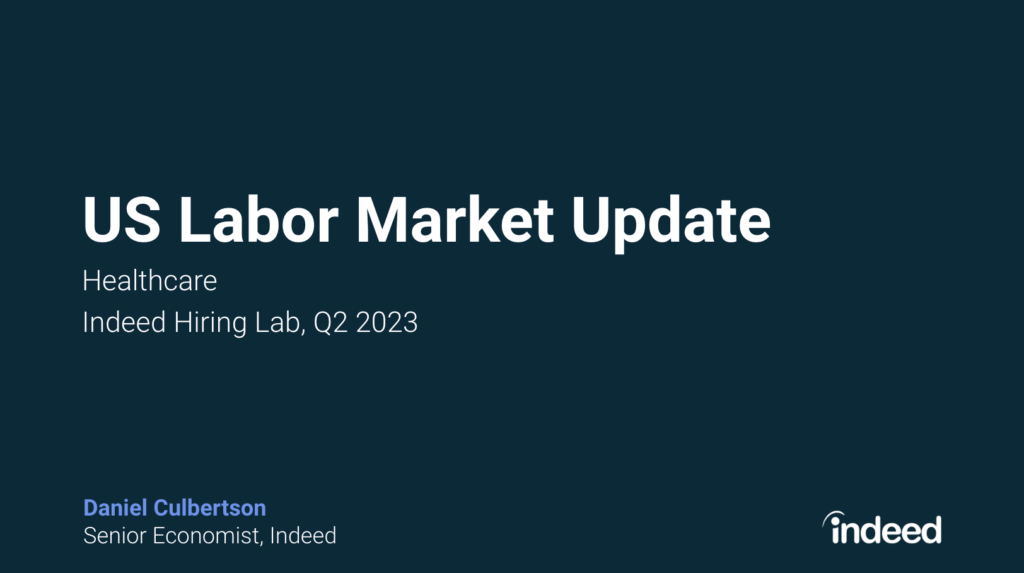Key points
- Nursing roles attract the greatest interest from workers in other sectors, with nearly half of the clicks on nursing jobs coming from non-nurses, though interest has faded over the past year.
- Software development positions have remained popular with both job seekers and existing workers, despite recent tech layoffs and declining demand.
- Workers in high-paying jobs and/or roles that require extensive training or licensing generally appear to be less interested in changing occupations.
- Employers in less attractive sectors appear to be trying to entice workers with faster wage increases.
There are any number of reasons why workers may be interested in a career change, both positive (higher pay, better work-life balance, etc.) and negative (job dissatisfaction, health concerns, etc.), and those motivating factors often remain constant across industry segments. But an analysis of job seeker behavior finds that some sectors, notably nursing and software development, appear more attractive than others to workers seeking a change.
Indeed data on job seeker-reported occupations, linked with clicks on postings, allows us to see both how often workers are exploring opportunities outside their current field, and identify which sectors are attracting the most interest. While searching outside their current occupation doesn’t necessarily mean a person will switch careers, it may indicate that they are at least open to the idea and/or not completely satisfied with their current field. Measuring this openness is an indicator of job seeker preferences and may tell us something about what jobs people want the most, and which ones they may want to leave.
Nursing and software development roles appear popular both with those already in them and those seeking a new opportunity. However, job seeker interest in nursing roles has waned in the last year, with a declining share of clicks on nursing job postings coming from other fields, and current nurses seeking other opportunities at higher rates. On the other hand, the attractiveness of software development jobs appears to have picked up, even in the face of mounting layoffs and declining employer demand.
Non-nurses are still interested in nursing, but the attraction has faded
The first way we measured occupational-switching interest was to look at the rate of clicks on a job posting in a given sector that came from workers currently employed in roles outside that sector (what we call “inclicks” or “inbound clicks”). An example of an inclick would be a job posting for an accountant receiving a click from a worker currently employed in the human resources sector. Inbound clicks can help us identify the sectors most interesting to potential career switchers.
As of June 2023, software development and nursing job postings on Indeed garnered the most interest from workers in other occupations. Nursing had an inbound click rate of 49%, with almost half of the clicks on those jobs coming from non-nurses. Nursing interest, however, has faded over the past year — in June 2022, the inclick rate was 55%. Over the same time, the inclick rate for software development jobs rose from 33% to 46%, indicating heightened interest in these roles.
Outside interest in nursing roles comes from a variety of sectors, the largest being medical technicians (6% of inbound clicks), community & social service (4%), and administrative assistance (4%). Of the three largest inbound click sources for software development job postings, two came from tech-adjacent fields — information design & documentation and IT operations & helpdesk — which drew a collective 9% of inbound clicks, while management roles accounted for an additional 6%.
Software development workers are the least interested in leaving their fields
We also examined the rate of clicks from jobseekers in a given industry looking at roles outside of that space (“outclicks”). An example of outclicks is a worker who lists “marketing associate” on their resume (marketing sector) and then looks at a Python-developer job posting (software development). Measuring outclicks in this way allows us to see where “sector stickiness” may be highest and in which sectors workers are most interested in staying put.
As of June 2023, just 42% of workers who reported working most recently in software development looked at jobs outside their field, down from 50% at the same time last year. Nursing followed, with an outclick share of 60%, up from 55% in June 2022.
These numbers suggest that software development workers remain devoted to their field, despite reports of tech layoffs and declining employer demand. At the end of June, job postings for software developers were nearly 19% below pre-pandemic levels, even as job postings overall remained 27% higher than their pre-pandemic baseline. It’s also possible that fewer software development opportunities and growing layoff fears may also be influencing some currently employed software developers to hunker down and search out of their sector less, which may be leading to a lower outbound click share.
This devotion to software development may also be attributable (in part) to the high degree of skill specialization, training, and experience often required for these roles. Similarly, other relatively “sticky” sectors like nursing and driving also often require specialized training, experience, and/or licensing. Given the time investment often needed to obtain these skills and credentials, it would make sense that these workers could be reluctant to switch things up.
Even so, despite those potential barriers to job change, there are more nurses looking outside their field now than there were a year ago. In fact, the nursing sector experienced the largest increase in outbound click share between 2022 and 2023, a trend that may continue. In a recent survey of US nurses, more than 600,000 registered nurses said they intended to leave their jobs by 2027, with many citing stress and burnout reasons. Stress and unhappiness in the workplace were recently identified as the second-highest motivators behind a search for new opportunities, behind only pay considerations.
The potential role of pay and wage growth in retaining and attracting workers
In addition to skill and job requirements, wages also appear to play a role in attracting and retaining workers. For workers in typically high-paying sectors like software development, finding comparable or higher pay in another occupation may be difficult, which may lead to fewer outbound clicks from those high-wage jobs and less interest flowing into other lower-pay sectors.
While many sectors have high outclick shares and low rates of inclicks, six stand out as relatively more attractive due to their ability to both retain the interest of current workers and garner clicks from outside their field. These sectors are software development, nursing, dental, driving, accounting, and food preparation & service (the blue-shaded area of the chart below). On the flip side, inbound interest tends to be lower, and current workers seem more open to switching fields in sectors including sales, civil engineering, and child care (the pink-shaded area in the chart below). Taken together, we found that the typical wage level of less-popular sectors tends to be mixed, while high-wage sectors comprise the majority of the more-popular area.
Food preparation & service, a typically low-wage sector, stands out — its inclicks are up three percentage points over the past year, while its outclicks have fallen by five points. This increased attractiveness may be attributable in part to robust wage growth, which has been highest among low-wage sectors coming out of the pandemic. And while low-paying sector wage growth has slowed markedly over the last year, the sectors with declining inclick rates correlated well with the occupational groups that had the highest increases in posted wage growth in Indeed’s Wage Tracker over the last year. Given the continued competition for workers in some sectors, it stands to reason that employers may be more willing to raise wages to attract workers when inbound interest is low.
Conclusion
Nursing and software development stand out as attractive fields for potential career switchers, while factors such as skill-specialization and wages play crucial roles in shaping job-seeker preferences. As the job market evolves, understanding these factors will empower employers to create effective recruitment and retention strategies to maintain and attract a thriving workforce.
Methodology
Jobseekers are allocated an occupational category based on the last job title in their profile uploaded on Indeed. Jobseeker clicks are designated as an occupation outclick if they click on job titles in a different category from the last job on their resume. For example, if a Java developer clicks on a posting for a data scientist, then that would be considered an outclick. An inclick, by comparison, refers to clicks into an occupation from a jobseeker whose current job sits in a different occupational category. A Kendall correlation test returned a tau value of -0.27 with a p-value of 0.03 for the relationship between wage growth change and inclick share change between 2022 and 2023.



